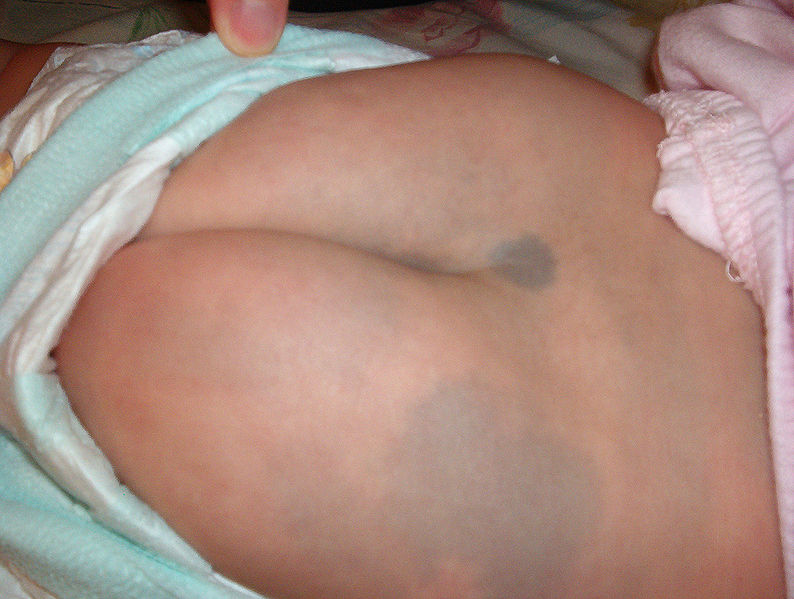WBR0433
Jump to navigation
Jump to search
| Author | [[PageAuthor::Rim Halaby, M.D. [1] (Reviewed by Serge Korjian and Yazan Daaboul, M.D.)]] |
|---|---|
| Exam Type | ExamType::USMLE Step 1 |
| Main Category | MainCategory::Behavioral Science/Psychiatry |
| Sub Category | SubCategory::Dermatology |
| Prompt | [[Prompt::A 6-month-old girl is brought to the pediatrician's office by her parents for concerns over persistent bruising over the lower back. Otherwise, the parents report that the child is developing normally. On physical examination, the physician notes the lesions shown in the image below. Which of the following should be the next step in the management of this patient condition? |
| Answer A | AnswerA::Reassurance |
| Answer A Explanation | [[AnswerAExp::In the context of a normally growing infant, the physician should reassure the parents since Mongolian spots are self-limited skin lesions that disappear by early childhood.]] |
| Answer B | AnswerB::Calling the police |
| Answer B Explanation | [[AnswerBExp::Although child abuse should always be in the differential diagnosis of Mongolian spots, child abuse would not cause such characteristic bluish-lesions despite their resemblance to traumatic bruises. Children who are victims of abuse may have other findings on physical examination and work-up, such as multiple fractures of different age on skeletal x-ray, retinal hemorrhages, and subdural hematomas. In the case of child abuse, the infant care is typically compromised as well, and the development of the child may be delayed.]] |
| Answer C | AnswerC::Performing x-rays |
| Answer C Explanation | [[AnswerCExp::Further testing is not required for patients with Mongolian spots who are otherwise healthy with no suspicion for child abuse.]] |
| Answer D | AnswerD::Genetic testing |
| Answer D Explanation | [[AnswerDExp::Further testing is not required for patients with Mongolian spots who are otherwise healthy.]] |
| Answer E | AnswerE::Bone marrow biopsy |
| Answer E Explanation | [[AnswerEExp::A bone marrow biopsy is indicated in the case of a hematologic malignancy that can cause thrombocytopenia and easy bruising. However, the infant is healthy and is growing well. His presentation is not suspicious for a hematologic malignancy.]] |
| Right Answer | RightAnswer::A |
| Explanation | [[Explanation::The patient’s physical examination is consistent with Mongolian spots or congenital dermal melanocytosis. Mongolian spots are characterized by one or more benign, bluish, patchy, self-limited lesions that are very common among infants and typically are located in the lower back region, the buttocks, and/or the shoulders. The condition results from entrapped melanocytes in the dermis due to inhibited neural crest cell migration to the epidermal layer. Diagnosis of Mongolian spots is clinical. Although these lesions resemble bruising, real bruises usually change color in a short duration and usually appear in different stages of healing. Further work-up in an otherwise healthy child is unnecessary, and treatment is not required given the self-limited nature of the lesions. Therefore, the physician in this vignette should reassure the patient’s family without the need for any further investigation. Educational Objective: Mongolian spots are benign, patchy, self-limited lesions that are very common among infants. Diagnosis of Mongolian spots is clinical, and no further work-up or investigation is required when Mongolian spots are diagnosed in an otherwise healthy infant. |
| Approved | Approved::No |
| Keyword | WBRKeyword::Mongolian spot, WBRKeyword::Child abuse, WBRKeyword::Physical examination, WBRKeyword::Infant, WBRKeyword::Congenital dermal melanocytosis |
| Linked Question | Linked:: |
| Order in Linked Questions | LinkedOrder:: |
